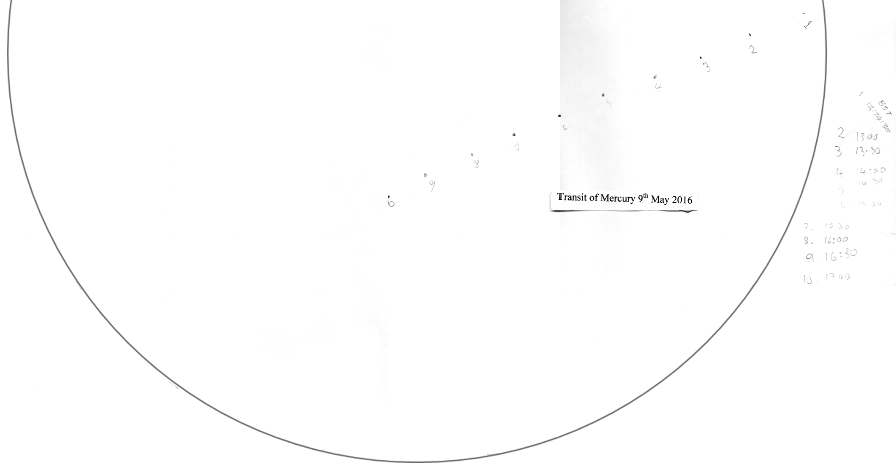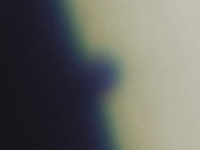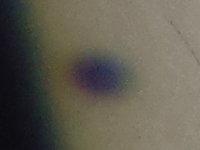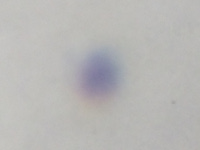Orwell Astronomical Society (Ipswich)
Transit of Mercury, 09 May 2016
James Appleton and Martin Cook coordinated arrangements for observing the transit from Orwell Park Observatory. After some debate, they decided to utilise the Tomline Refractor to project an image of the solar disk, which could be studied visually and photographed, leaving observers on the balconies of the Observatory to use more sophisticated electronic imaging in both white light and Hα wavelengths.
Preparations
Experience with the transit of Mercury on 07 May 2003 and the transit of Venus of 08 June 2004 demonstrated the need for an effective sunshade to minimise ingress of ambient sunlight into the dome and thereby improve the contrast of the projected image. The sunshade used in 2004 comprised essentially a lengthy home-made blind attached to the dome via nylon cords passing through eyes screwed into the wooden framework around the aperture. The end of the telescope holding the object glass (OG) protruded through the sunshade. By adjusting the length of various cords in a coordinated manner, the sunshade could be raised and lowered to match the altitude to which the telescope was directed. The sunshade was effective to an extent but did not fit well the curvature of the inside of the dome and thus allowed the ingress of considerable ambient light. James and Martin therefore planned a new, improved sunshade.
Planning started several weeks before the transit. Initial thoughts were simply to fabricate a sunshade similar to that used in 2004 but with more cords enabling it to be held closer to the curvature of the dome. Eventually, however, a more elaborate scheme evolved, based on a pair of runners fitted to the interior side of the aperture of the dome, with the sunshade held in position between the interior of the dome and the runners. Matthew Leeks constructed the runners from 15 mm copper pipe and brought them to the Observatory on Wednesday 27 April where, together with Alan Smith, he shaped them to the correct curvature. The following Wednesday, James, Martin, Matthew and Alan erected scaffolding in the dome and secured the runners in position, using brackets fabricated by Martin (figures 1 and 2). Two days later, James constructed a sunshade from 10 m of material secured to wooden battens; despite leaving work early to begin the task, practical difficulties meant that work continued late into the night! The following day, James, Martin, Matthew and Alan attended the Observatory and fitted the sunshade; as the Sun was shining in a clear sky, they were able to test its effectiveness. Unfortunately, it was immediately apparent that the material was just too thin and the degree of obscuration was far short of what was necessary. With the aperture of the dome turned in the opposite direction to the Sun, the blue of the sky was clearly visible (figure 3); conversely, with the aperture turned towards the Sun, the material allowed enough sunlight to enter the dome to cast a distinct shadow of the telescope on the projection screen, and the solar image had poor contrast (figure 4). The personnel withdrew to consider the best course of action.
The following day, James and Martin returned to the dome determined to improve matters. Enhancements included doubling the thickness of material used for most of the length of the sunshade (figure 5), obscuring the arched windows at the base of the dome, and fitting a 1 m square shadow screen at the OG-end of the telescope. After many hours of work, the task was complete and the dome was ready! The new sunshade worked well: figure 6, taken on the day of the transit, looking along the length of the telescope, shows the considerable attenuation of direct sunlight provided by the sunshade, and shows too the shadow screen. Collectively, the light-exclusion measures considerably reduced the ambient illumination in the dome. The Tomline Refractor produced an image of the Sun 50 cm in diameter, with good contrast, and no hint of a shadow of the telescope on the projection screen.
Arrival At Orwell Park On 09 May
On the day of the transit, James, Martin and David Murton were first to arrive at the Observatory, at approximately 09.30am. After helping to transport David's imaging equipment to the south-west balcony, where he began setting up, James and Martin went to the dome to prepare the Tomline Refractor. They selected a large, ex-military surplus eyepiece (the used for observation of the transit of Venus in 2004). The new sunshade obscured the aperture of the dome so well that initially it was difficult to align the Tomline Refractor on the Sun. Eventually the pair succeeded, whereupon two sunspot groups (Active Regions 2542 and 2543) together with a few isolated sunspots were immediately visible. There was no evidence of granulation or plages. Martin fitted his Canon 1100D and Samsung WB750 cameras to the mounting bracket at the eyepiece end of the Tomline Refractor (figure 7) and centred them on the region where 1st contact would occur. He secured a large radio-synchronised "Rugby" clock (properly an MSF clock) to the corner of the projection screen for timing events. Once the preparations were complete, he took some photos of AR2542 (figure 8) to test the cameras.
Bill Barton and Paul Whiting arrived at the observatory at 10.00am, and John Wainwright shortly thereafter. Preparations complete, the observers settled down to wait for ingress to begin. The weather was promising: the sky was clear! To provide some light entertainment, Martin employed an industrial thermocouple to measure the temperature of the Sun's rays concentrated by the eyepiece of the Tomline Refractor. After a few seconds at the focus, the thermocouple glowed bright red and the temperature reading went off the scale at 750°C! (Figure 9.) Shortly after 11.00am, more observers arrived: Adrian Cubitt, Tina Hammond, Richard Stansfield and Mike Whybray. Figure 10 shows some of the observers studying the projection, waiting for the transit to begin.
Approximately 15 minutes before the transit started, some thin cloud passed in front of the Sun, causing a loss of definition of the projected image. Fortunately, the cloud passed after approximately five minutes, and definition returned. The observers gathered around the projection screen and Martin set the cameras so that the 1100D took a still image every approximately 4 s and the WB750 recorded a video (which terminated shortly after 2nd contact). A handheld "Rugby" clock was placed briefly in the field of view of the WB750 to provide a timing reference for later, off-line analysis of the video. The observers then concentrated on the image, waiting for 1st contact.
Ingress Phase
The observers recorded the following event times (UT). Paul was first to detect the barely-perceptible indentation of the silhouette of Mercury on the Sun's east limb, at 11:12:45. Once he indicated the phenomenon, other observers were immediately able to see it too, thus all observers were reasonably confident that they had observed the silhouette of Mercury within a few seconds of the instant of 1st contact. However, there was no such certainty in the estimation of 2nd contact due to a prolonged teardrop effect. At 11:13:32, Paul detected the teardrop, but this was not confirmed by other observers. At 11:14:20, Paul called out an observation of 2nd contact, but again this was not confirmed by other observers, and was later thought to be an error. Paul called out the instant of 2nd contact again at 11:14:36 and for a third time at 11:14:39 and several observers in the dome agreed that 2nd contact occurred somewhere around these times. However, other observers were of the opinion that there was still a pronounced teardrop effect at this time, and the silhouette of Mercury had not detached from the solar limb. Nonetheless, all present agreed that 2nd contact had certainly occurred before 11:15:16.
Later, James and Martin independently analysed the video recording and produced off-line estimates of event times. The following table compares the various empirical estimates together with predicted contact times calculated using the NASA JPL ephemeris DE-431.
| Estimate | 1st contact | 2nd contact |
| Observers in dome | 11:12:45 | Maybe 11:14:36 - 11:14:39. Certainly by 11:15:16. |
| James Appleton (video) | 11:12:38 | 11:15:35 |
| Martin Cook (video) | 11:12:38 | 11:15:33 |
| Predicted | 11:12:23 | 11:15:35 |
Estimates of event times (UT).
Figure 11 is a montage of the images from the 1100D during the period 11:12:37 - 11:16:15 UT, from approximately the instant of 1st contact until after 2nd contact. It shows the very pronounced teardrop effect extending from approximately 11:14:09 - 11:15:27 UT. (Note that the timer triggering the camera was not completely accurate, and a few images deviate from the intended 4 second periodicity.) Observers with handheld cameras also recorded the teardrop effect: see figure 12, compiled from images by James Appleton taken with a Canon PowerShot SX220, 11:13:24 - 11:15:48 UT (note that the images are not evenly spaced in time).

11:12:37

11:12:41

11:12:45

11:12:49

11:12:53

11:12:57

11:13:01

11:13:05

11:13:09

11:13:13

11:13:17

11:13:21

11:13:25

11:13:29

11:13:33

11:13:37

11:13:41

11:13:45

11:13:49

11:13:53

11:13:57

11:14:01

11:14:07

11:14:09

11:14:13

11:14:17

11:14:23

11:14:27

11:14:31

11:14:35

11:14:39

11:14:43

11:14:47

11:14:51

11:14:55

11:14:59

11:15:03

11:15:07

11:15:11

11:15:15

11:15:19

11:15:23

11:15:27

11:15:31

11:15:35

11:15:39

11:15:43

11:15:47

11:15:51

11:15:55

11:15:59

11:16:03

11:16:07

11:16:11

11:16:15
Fig. 11. Images taken approximately every 4 s during ingress. (MPC)

11:13:24

11:14:50

11:14:54

11:15:28

11:15:44

11:15:48
Fig. 12. Images taken during ingress. (JMA)
After 2nd contact, the diameter of the silhouette of Mercury was measured as approximately 3 mm, illustrating the huge difference in scale between the planet and the Sun, the image of which had a diameter of approximately 50 cm.
Mid-transit
After the ingress phase, observers in the dome continued to observe the transit. Of course, observations were not conducted as diligently as during the ingress phase, as little of interest was expected to happen. Figure 13 (by John Wainwright) shows the scene in the dome roughly an hour after ingress: a sense of ennui is evident! Fortunately, a diversion soon presented itself. The sky became noticeably hazy. Martin siezed the opportunity to demonstrate the attenuation of solar radiation by haze, by once more holding the industrial thermocouple at the focus of the Tomeline Refractor: this time, the temperature topped out at a mere 505°C!
Throughout the transit, observers in the dome plotted on a large sheet of paper, attached to the projection screen, the progress of the silhouette of Mercury across the solar disk. Figure 14 shows their efforts. (Note, the projection is E-W reversed relative to the naked eye view.)

Fig. 14. Progress of the silhouette of Mercury across the solar disk.
Chromatic Aberration
The OG of the Tomline Refractor is an unsophisticated doublet, manufactured by Merz in the early 1870s, comprising a crown glass and a flint glass. It provides colour correction at just two wavelengths (unlike modern multi-element OGs which provide colour correction at three or even four wavelengths) and is not of high quality by today's standards and, unsurprisingly, suffers from chromatic aberration.
Chromatic aberration was apparent in the projected image during the transit. It was visible to the eye, but was sometimes difficult to photograph, and sometimes easy, perhaps determined by the spectral response of the camera. The effect was radial, the black disk of Mercury exhibiting a green/yellow fringe on the circumferential arc closest to the centre of the image and a red/purple fringe on the diametrically opposite arc. In addition, the limb of the Sun was bordered by a yellow fringe and, beyond, a green/blue fringe. Off-line analysis of images afterwards, decomposing colour photographs into RGB components, revealed that green and red wavelengths were in focus, but blue was not.
Some photographs of the aberration are below. Figure 15, by Tina Hammond, using a Samsung mobile phone, at 11:14:22 UT (between 1st and 2nd contact), shows the green and yellow fringe around both the solar limb and the limb of Mercury facing the centre of the image. Figure 16, also by Tina, at 11:16:59 UT, shortly after 2nd contact, shows clearly chromatic aberration around the entire limb of Mercury. Lindsay Hammond-Smith (last of the observers to arrive, circa 4.00pm) captured figure 17 at 16:03:00 UT, also showing chromatic aberration around the entire limb of the planet. At this time, Mercury appeared much closer to the centre of the disk so the aberration is less pronounced, and the sunshade was less effective, allowing more ambient light to enter the dome, so the image suffers from reduced contrast compared to those captured during the ingress phase.
 Fig. 15. 11:14:22 UT.
Fig. 15. 11:14:22 UT.
 Fig. 16. 11:16:59 UT.
Fig. 16. 11:16:59 UT.
 Fig. 17. 16:03:00 UT.
Fig. 17. 16:03:00 UT.
End Of Observations
As the afternoon progressed, the sky became increasingly hazy and cloudy, although with some clear patches. At 5.00pm, thick cloud began rolling in and, by 5.15pm, the sky was overcast. Reluctantly, with no hope of further observations, the observers in the dome packed away the equipment. By 6.00pm, it was raining.
David observed from the south-west balcony of the Observatory using two instruments as follows:
At 10.30am, Paul used a handheld scanner to tune in to a schools radio link with Major Tim Peake, orbiting some 400 km above in the International Space Station. The communication lasted a few minutes, during which Tim responded to a question posed by a pupil about time dilation.
After observing the ingress phase of the transit in the dome, Paul observed during mid-transit from the south balcony of the Observatory using a William Optics GT-81 with Nikon D3200 camera on Skywatcher mount. Figure 24 shows an image captured in white light at 11:44 UT, 1/1600 s exposure at ISO 400.
Location
Monmouth Close, South Ipswich.
Weather
sunny with cirrus cloud.
Equipment
QHY5 II L colour camera attached to Coronado PST on Sky-watcher Star Adventurer mount. Images captured using Firecapture v2.3 and Registax 6.
As I was due to start work late in the afternoon, I decided to observe the transit from home. With first contact due at 11.12, I hoped to collect images and data over a four-hour period. The day before, I performed a "dress rehearsal" to establish the best viewing position in the garden and to test the camera settings.
The morning of transit day began sunny and warm, although with some cirrus cloud. The BBC weather app predicted mainly sunny skies with increasing cloud cover and rain beginning at 7.00pm. I set up my equipment in the shade of my "observing shed" (figure 25) with an umbrella strategically placed over the laptop! By 11.00 UT, everything was set up and ready to go. The view of the Sun in Hα at this time showed a low level of activity with one small sunspot, a few small prominences, a couple of large filaments and some areas of plage.
Unfortunately, I did not start recording images until 11:14:46 UT, shortly after 1st contact, so do not have a timing for this event. I estimate that 2nd contact occurred two seconds after I started recording, at 11:14:48 UT. There was a nice prominence visible at the point of ingress; this is well captured in figure 26, taken with an exposure set to highlight prominences.
I continued imaging at regular intervals for the next hour. I experimented with my camera settings, overexposing the disc of the Sun to give more contrast and to highlight the prominences. It was, however, becoming apparent that the high level cloud was becoming more of a problem, causing a "blooming" effect in some of the images. See figures 27 and 28. Thereafter, I took images occasionally through the transit: see figures 29 and 30.
My neighbour arrived to view proceedings. She kindly loaned me a large parasol which was very welcome as the areas of shade in the garden were diminishing!
At 13.45 UT, cloud cover was becoming thicker and I took a break from imaging. I removed the camera from the PST and replaced it with an eyepiece. It proved still possible to view the transit visually.
By 14.20 UT, the sky began to clear so I re-inserted the camera, tweaked the settings to show more surface detail and, I would say, captured my best images - see figures 31 and 32. I recorded my last image at 14:37 UT, then packed away my equipment and got ready for work. By the time I left Ipswich at 17.15 UT, it had started to rain. However, it had been a successful observation.
Figure 33 shows a white light image taken at 15:04 UT using a 120 mm f7.5 refractor with Thousand Oaks Black Polymer White Light Filter. Canon D60a camera, 1/200 s exposure at ISO 200.
I used the following equipment for observation and imaging:
Observations made from Grundisburgh, IP13 6RE.
I started imaging at around 10:00 UT with occasional exposures. During the ingress phase, from 11:12:02 to 11:16:08 I used an interval timer to capture an image with the 1100D every 2 seconds (nominal). From 11:20 to 16:38, with the silhouette of Mercury clear of the limb, I captured an image every 5 minutes (nominal), except at the end of the period. Finally, disappearance of the Sun and Mercury behind a fir tree co-incided with the arrival of dense cloud cover and I terminated observations at 16:40 UT. In a spirit of optimism, I left the equipment in place, hoping for a break in the clouds, until it stated to rain at 18:15 UT.
A heat haze badly affected the images; this was particularly apparent in undulation and movement of the solar limb. As a result, I found it difficult to estimate the instants of 1st and 2nd contact. My estimates are: 11:12:52 and 11:15:34 UT respectively. The teardrop effect was very pronounced around 2nd contact, probably because of poor seeing. Figure 34, a montage of images from the 1100D from before 1st contact to after 2nd contact (specifically 11:12:46 - 12:16:08), shows the silhouette of Mercury initially appearing out of undulations on the solar limb, and the development of the teardrop effect.

11:12:46

11:12:48

11:12:50

11:12:52

11:12:54

11:12:56

11:12:57

11:12:59

11:13:01

11:13:03

11:13:05

11:13:07

11:13:09

11:13:10

11:13:12

11:13:14

11:13:16

11:13:18

11:13:20

11:13:22

11:13:25

11:13:26

11:13:29

11:13:30

11:13:32

11:13:34

11:13:36

11:13:38

11:13:40

11:13:42

11:13:44

11:13:50

11:13:52

11:13:54

11:13:57

11:13:59

11:14:01

11:14:03

11:14:05

11:14:07

11:14:09

11:14:12

11:14:14

11:14:17

11:14:19

11:14:21

11:14:23

11:14:25

11:14:26

11:14:29

11:14:31

11:14:33

11:14:35

11:14:37

11:14:39

11:14:41

11:14:43

11:14:45

11:14:47

11:14:49

11:14:51

11:14:53

11:14:55

11:14:57

11:14:59

11:15:01

11:15:03

11:15:05

11:15:08

11:15:10

11:15:12

11:15:13

11:15:15

11:15:17

11:15:19

11:15:21

11:15:23

11:15:26

11:15:28

11:15:30

11:15:32

11:15:34

11:15:36

11:15:38

11:15:40

11:15:42

11:15:44

11:15:46

11:15:48

11:15:50

11:15:52

11:15:54

11:15:56

11:15:58

11:16:01

11:16:03

11:16:05

11:16:07

11:16:08
Fig. 34. Images taken approximately every 2 s during ingress.
During mid-transit, high-level cirrus clouds created a full solar halo (figure 35). There was a fair easterly breeze, which I deflected from my equipment with appropriately-placed wind-breaks (figure 36).
Throughout the day, I used a solar panel to estimate the intensity of solar radiation. Figure 37 shows the results: the graph of intensity is scaled in Watts, reflecting the power delivery capability of the solar panel. The underlying, approximately bell-shaped curve is subject to a large number of relatively high-frequency troughs associated with the passage of cloud.
Figure 38 is an animation of the transit compiled from images captured by the 1100D.
It's 09 May and I know full well that it's the day of the transit of Mercury. Unfortunately, I'm at work and there's a lot of cloud in the sky. Fortunately, an Understanding Company allows me to race home at lunch-time and out into the back garden with my 80 mm refractor (with appropriate solar filter fitted, of course) and an 8-28 mm zoom eyepiece.
My technical skills allow me to take astro-photos by the simple method of pointing my camera down the eyepiece! I had to hand three cameras - a Canon 100D, a Canon HS50 and a Nikon Coolpix S6400 – each with different degrees of suitability to the task. Figures 39 - 42 show the results of my afternoon in the garden. All were obtained with the camera set to "auto".
My observations were curtailed by a combination of cloud coverage around 4.00pm (approximately half-way through the transit) and an interest in making the most of my afternoon off to see some of the Essex vs Sri Lanka cricket match!
The good weather on 09 May encouraged me to take out my ETX 125 PE and use it for the day. I used a 40 mm Fullerscopes eyepiece and drew power from a portable battery pack. I used the Sun-finder to align the instrument.
Unfortunately, I encountered some problems at first. Stray light in the eyepiece tube gave the impression that the solar filter was damaged, and I therefore hesitated to use it. In fact, the filter turned out to be OK but, by the time I had established this, I had missed 1st and 2nd contact. Mrs P and I then observed the slow progress of the black dot of Mercury across the face of the Sun until cloud terminated observations. Mercury appeared like a very tiny speck indeed.
The telescope has recently been repaired. It tracked Mercury very accurately, so the repair was worthwhile.
Figures 43 and 44 show the telescope and Sun-finder.
James Appleton, Nigel Evans, Andy Gibbs, David Murton, Mike O'Mahony, Gerry Pilling, Neil Short, Alan Smith, Paul Whiting, FRAS